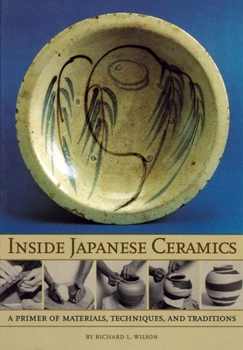Inside Japanese Ceramics: Primer of Materials, Techniques, and Traditions
Select Format
Select Condition 
Book Overview
This practical and supremely useful manual is the first comprehensive, hands-on introduction to Japanese ceramics. The Japanese ceramics tradition is without compare in its technical and stylistic... This description may be from another edition of this product.
Format:Paperback
Language:English
ISBN:0834804425
ISBN13:9780834804425
Release Date:October 1999
Publisher:Weatherhill
Length:192 Pages
Weight:1.45 lbs.
Dimensions:0.6" x 7.2" x 10.0"
Customer Reviews
4 ratings
Intermediate level introduction
Published by Thriftbooks.com User , 15 years ago
Although a textbook for ceramist, it is a stimulating reading for people with a general interest in ceramics. I found the book fascinating.The book provides an introduction to the techniques of japanese wood fired ceramics, its history and context. The book has plenty of well chosen ilustrations along with the well thought out, enjoyable writing.
Inside Japanese Ceramics
Published by Thriftbooks.com User , 16 years ago
I am a pottery instructor and over the years continually have Jananese students. Japanese pottery in always as Function as it is Decorative. This book is a wonderful tool in helping me to explain tecniques to my students. (Especailly when they don't speak much English) As the old saying goes a picture is worth a thousand words. The step by step pictoral instructions are so helpful. If you are interested in Japanese pottery this is a must have book.
A Great Intro to Yakimono
Published by Thriftbooks.com User , 17 years ago
This book may look like a quick , light read, but it is a great introduction to Japanese wood fired ceramics (yakimono). A good amount of illustrations help to guide you along with the well thought out, enjoyable writing. A good addition to the academic library and a nice resource for artists as well.
An essential guide for the potter or the collector.
Published by Thriftbooks.com User , 25 years ago
This volume presents not only the "how-to" of Japanese ceramics, but broader considerations of their significance within the context of world ceramics. Richard Wilson has not only trained extensively with Japanese potters, but is also thoroughly familiar with the many historical ceramic types which form the tradition which continues today. Virtually no art potters today remain unaffected by the tremendous impact of Japanese ceramics, and Wilson's book provides the contemporary ceramist with a reference that is at once useful and inspiring. The text is clear and straightforward in the explanatory sections while at the same time conveying to the reader the fascinating historical and cultural context on which the many techniques are based. The color illustrations are first class, and the technical photographs, illustrations and diagrams are clear, easy to read and appropriately placed. As in his earlier volume, The Art of Ogata Kenzan, Wilson has taken great pains to ensure that his information is both accurate and as complete as possible. Eschewing past tendencies of Western ceramists to mainly focus either on the externals of Japanese pots or on a touchy-feely, pseudo-philosophical/religous approach, Wilson sees the essence of Japanese ceramics as intrinsically linked to production process and functionality. As he summarizes, "(The Japanese ceramics legacy) suggests... renouncing artistic individualism... and rededicating oneself to personal discipline and harmony with materials, processes, and the user community. It implies thinking about the pots as part of an ongoing process, a relaxed conversation with the world, rather than as a kind of personal decree." Through this book, Richard Wilson has provided a great volume of reference not only for those who "do" ceramics, but for those who love ceramics as well.






